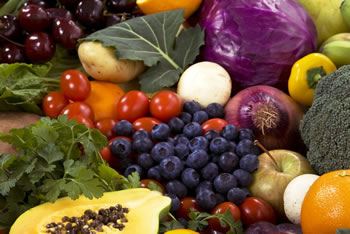
Foods may be classified, in relation to the metabolic process, as either acid or alkaline. Alkalis are soluble salts and acids are corrosive agents which have trouble combining with other things. A balanced diet contains 35% acid forming foods and 65% alkaline. However, if the body is sick, then to restore health, the diet should really consist of 80% alkaline forming foods and 20% acid forming foods.
Human blood pH should be slightly alkaline (7.35-7.45). Below or above this range will lead to a plethora of symptoms and eventually disease. A pH of 7.0 is neutral. A pH below 7.0 is acidic. A pH above 7.0 is alkaline.
The alkalinity of the blood has to be kept almost constant; even minor variations are dangerous. If the blood lowers to pH 6.95 (barely over the line on the acidic side), a coma and even death can result. And if the concentration in the blood changes from 7.4 to 7.7, tetanic convulsions may occur.
An acidic pH can result from an acid forming diet, emotional stress, toxic overload, or any process that deprives the cells of oxygen and other nutrients. The body will try to compensate for acidic pH by using alkaline minerals. If the diet does not contain enough minerals to compensate, a build up of acid in the cells will occur.
Any acidic overload will decrease the body’s ability to absorb minerals and other nutrients, decrease the energy production in the cells, decrease it’s ability to repair damaged cells, decrease it’s ability to detoxify heavy metals, weaken the immune system and allow tumor cells to thrive, and generally make the body more susceptible to fatigue and illness.
The reason acidosis (a dominant acidic position in the body) is more common in our society is mostly due to the typical Western diet, which is far too high in acid producing foods such as, meat, other animal products such as eggs and dairy – and far too low in alkaline producing foods like fresh vegetables, lentils, seeds, nuts and fruits.
Additionally, we eat acid producing processed foods like white flour and sugar and drink acid producing beverages like coffee and soft drinks. We use too many drugs, which are acid forming and we use artificial chemical sweeteners, which are generally poisonous and extremely acid forming. One of the best things we can do to correct an overly acidic body is to clean up our diet and lifestyle.
Please bear in mind that foods cannot be described as absolutely alkaline, or absolutely acidic. This is why you will find some disagreement about where foods are positioned on the spectrum. The truth is that it’s difficult to be definitive about this because some food groups are quite large and some foods in the same group can vary quite widely. The situation is further complicated by how food is cooked. Something that begins alkaline can actually be made acidic through the cooking process.
In addition, there is arguably the most relevant factor, yet the least considered, which is chewing. How you chew your food, has a bearing on whether it becomes acidic, or is neutralised, or even becomes more alkaline. Something that begins as alkaline when it enters the mouth can be corrupted and made acidic through a lack of chewing, which leads to poor digestion. So taking chewing seriously is an important part of this crucial subject.
Generally, alkaline forming foods include, most fruits, green vegetables, peas, beans, lentils, spices, herbs, seasonings, seeds and nuts.
Generally, acid forming foods include, meat, fish, poultry, eggs, grains, dairy products and legumes.
The lists below give some idea of the complexity surrounding the classification of foods.
Highly Alkaline
Grasses, Chlorella, Kale, Kelp, Spinach, Parsley, Broccoli, Sprouts, Sea Vegetables (Kelp), Green drinks, Pumpkin Seed, Limes, Sea Salt, Lemons, Lentils, Sweet Potato, Spirulina, Vegetable Juices, Baking Soda, Nectarine, Pineapple, Watermelon, Mineral Water, Raspberry, Tangerine, Onion, Persimmon.
Moderately Alkaline
Avocado, Beetroot, Capsicum/Pepper, Cabbage, Celery, Collard/Spring Greens, Endive, Garlic, Ginger, Green Beans, Lettuce, Mustard Greens, Okra, Onion, Radish, Red Onion, Rocket/Arugula, Tomato, Butter Beans, White Haricot Beans, Chia/Salba, Apples, Apricots, Olive, Broccoli, Cashews, Raw Honey, Mango.
Mildly Alkaline
Artichokes, Asparagus, Brussels Sprouts, Cauliflower, Carrot, Chives, Courgette/Zucchini, Leeks, New Baby Potatoes Peas, Rhubarb, Swede, Watercress, Grapefruit, Coconut, Quinoa, Spelt, Tofu, Other Beans & Legumes, Goat & Almond Milk, Most Herbs & Spices, Avocado Oil, Coconut Oil, Flax Oil/ Udo’s Oil, Wild Rice, Sunflower Seeds, Grapes.
Neutral / Mildly Acidic
Black Beans, Chickpeas/Garbanzos, Kidney Beans, Seitan, Cantaloupe, Currants, Fresh Dates, Nectarine, Plum, Sweet Cherry, Amaranth, Millet, Oats/Oatmeal, Soybeans, Soy/Hemp Protein, Freshwater Wild Fish, Rice & Soy Milk, Brazil Nuts, Pecan Nuts, Hazel Nuts, Sunflower Oil, Grapeseed Oil, Buckwheat, Brown Rice, Figs, Dates, Millet, Teff.
Moderately Acidic
Ketchup, Mayonnaise, Butter, Apple, Apricot, Banana, Blackberry, Blueberry, Cranberry, Grape Seed Oil, Mangosteen, Orange, Peach, Papaya, Pineapple, Strawberry, Basmati Rice, Oat Bran, Rye Bread, Wheat, Wholemeal Bread, Wild Rice, Wholemeal Pasta, Ocean Fish, Maize, Various Legumes, Rye, Veal, Chicken, Green Peas, Fructose, Peanuts.
Highly Acidic
Alcohol, Coffee & Black Tea, Fruit Juice (Sweetened / Concentrated / Packaged), Cocoa, Hazelnuts, Jam, Jelly, Mustard, Miso, Rice Syrup, Soy Sauce, Vinegar, Yeast, Dried Fruit, Beef, Chicken, Eggs, Farmed Fish, Pork, Shellfish, Cheese, Dairy, Artificial Sweeteners, Syrup, White Bread, Poultry, Lobster, Wine, Walnuts, Fried Foods, Brazil Nuts.
Acidosis
Acid/alkaline are the two characteristic conditions of blood and cell solution. Any solution is either more acid or more alkaline.Therefore, if acidic characteristics dominate, the solution is acid. An Acid solution always contains some alkaline factors, and a alkaline solution always contains some acid factors. Neutrality is an ‘ideal’ condition in which the value of acid and alkalinity is equal. However, in reality, what we eat or drink is always either more acid or alkaline.
According to modern biochemistry, it is not the organic matter of foods which leave acid or alkaline residues in the body, it is the inorganic matter (sulphur, phosphorus, potassium, sodium, magnesium and calcium) that determines the acidity or alkalinity of the body fluids. Food comparatively rich in acid forming elements are acid forming foods, those comparatively rich in alkaline forming elements are alkaline forming foods.
Acidosis is not in itself a specific disease; it is a description of the acidic status of the blood. It is also the root of many different diseases such as, chronic bowel conditions, severe migraines, diabetes, high blood pressure, arthritis, cancer, tumours and many more. Many people today have this blood condition without ever knowing it and it almost certainly causes death when not addressed.
Alkalosis is not as common as acidosis. It is a description of the blood where insufficient acid exists in the system, which can also cause a variety of health issues, such as: nausea, numbness, prolonged muscle spasms, muscle twitching, hand tremors etc.
An acidic condition inhibits nerve action, alkalinity stimulates nerve action. Someone whose pH is properly balanced can think clearly, decide and act well. They possess mental composure and calm.
A balanced diet, good hydration and carefully ‘targeted’ supplementation are a great help in maintaining the pH balance of the blood; however the ‘right’ regimen will not produce results in a day or two. It takes time to restore balance – weeks or maybe months. So patience is required.
If the blood becomes too acidic, then our bodies deposit the excess acidic substances in other areas of body in order that the blood will be able to maintain an alkaline state. If this patterns continues, then these areas increase in acidity and some cells die. These dead cells will, in turn, become acids. However, there are some cells that adapt to the ‘toxic’ environment. In other words, instead of dying as normal cells do in an acid environment, they actually survive becoming abnormal cells in the process. These abnormal cells are called ‘malignant’ cells. Malignant cells do not communicate and work cooperatively with our brains, nor with our DNA memory code. Therefore, malignant cells grow independently and without order, operating outside the ‘normal’ parameters of health and so disease follows.
.
This process is in fact how many cancers develop in the body – below is a summary of events:
1. Ingestion of many acid forming foods, fatty foods, refined foods, carcinogenic substances such as nitrates, and chemically treated foods in general.
2. Increased constipation often then follows, leading to a reabsorption of waste, causing a build up in the cells, tissues and organs.
3. Increase of acidity in the blood causes an increase of white cells and a decrease of red cells. The increased acidity also affects the natural killer cells in the body, undermining immunity.
4. Increase of acidity in the extra cellular fluids.
5. Increase of acidity into the intracellular fluids.
6. Birth of malignant cells. This is the stage of cancer called ‘initiation’.
7. The further consumption of acid foods, any chemical and drug treatment, exposure to radiation in any of its many forms can also exacerbate the situation. This stage is called cancer ‘promotion’.
There are two ways of classifying acid and alkaline foods.
One is the description of acid or alkaline foods, which means how much acidity or alkalinity exists in that food item.
The other is, acid or alkaline forming foods, which means the acid or alkaline forming ability of foods or put another way, the pH condition foods cause in the body after being digested. This is the one that has most bearing in terms of changing the body’s pH.
Although only a blood test can reveal the blood pH, it is possible to monitor the pH of the body with a simple home test kit of litmus or nitrozine paper. Testing a saliva and urine daily average for three days should reveal a pH of between 6.8 and 7.1. Some variation will occur depending on recent type of food and drink intake. Different body pH values are: stomach juice = 1.5, urine = 7.0, saliva = 7.1, and blood = 7.4.
Also see: Body pH and its Role in Health Maintenance and A Prescription For Health
